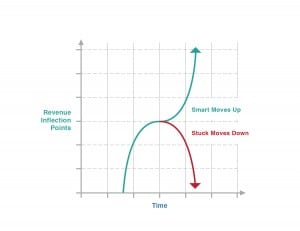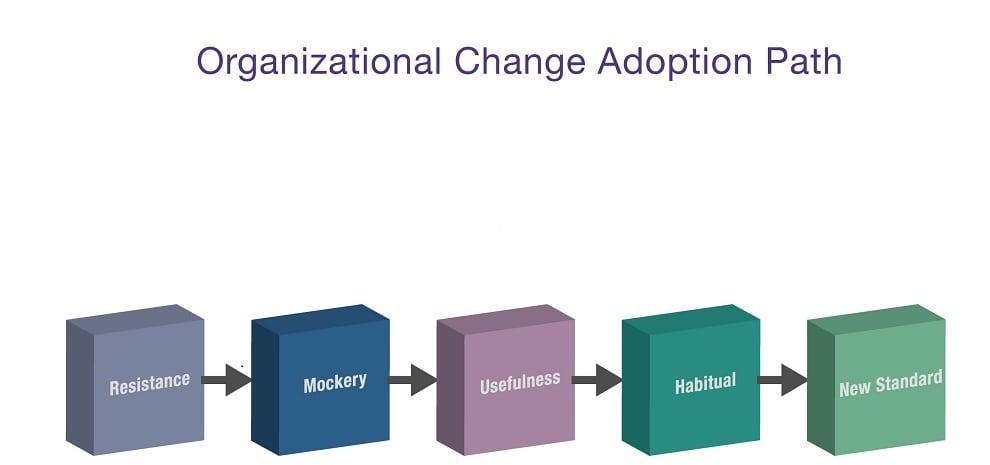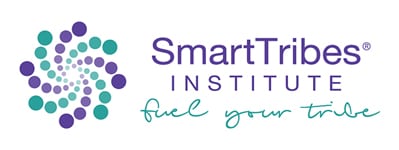
Cash Out or Hold Out: Is It Time To Sell Your Company?
August 21, 2012
The 3 Reasons Great Companies Stop Growing-And The Solution
October 16, 2012
Image Credit: Copyright 2011 Christine Comaford Assoc, LLC
Company Z, a financial services firm with nearly $100 million in annual revenue, was changing their business model. It was a big change—they were dumping one entire business unit and launching a new one. The team was none too happy about it. Some were fearful because they were employed in the now defunct business unit, and they’d have to learn new skills. The change was essential though, as due to market conditions the former unit would never become profitable.
As you’ve seen in my past blogs on change, not everyone in your organization is going to totally psyched and eager to celebrate change. And the biggest challenge with change is–drum roll please–resistance. But what most leaders miss is that resistance is simply the first stop on the quest for the holy grail: a new standard.
From my work with hundreds of successful entrepreneurs, top executives, and political leaders I’ve learned that organizational change is a continuum. It’s predictable, it can be guided, and here is how it works.
First people start with resistance. Why? Because thanks to Rodger Bailey’s terrific research on Meta Programs (I’ll cover this in a future blog), we know that 65% of Americans can only tolerate change if it is couched in a specific context. The context is “Sameness with Exception.” This means the “change” is really just an improvement to what we are already doing: the bad stuff is being removed, and good stuff is being increased. Seriously–this is the best way to package a change message. And don’t use the “c” (change) word—say “growth” instead.
Back to CEO Jessica, who did a masterful job managing Company Z’s organizational change. Here’s how she did it.
First, we trained the entire company on how change works and how to expect their brains and emotions to react. Jessica’s assistant had the CCA Organizational Change Adoption Path above expanded, printed and posted in the conference room so everyone could openly acknowledge where they were in the process.
Next, we laid out a plan to help the team navigate the five phases.
Resistance: This phase can pass fairly quickly when the leader stresses the “same with exception” nature of the change. That’s exactly what she did.
Mockery: I love this phase! It means people now have some emotional investment. They are past disinterest and resistance and we can engage them in telling us what they object to. We acknowledged their concerns and asked for their help in fixing what in the CEO’s growth plan was so “lame”. We asked for their agreement to follow the plan once their fixes were made. This led to…
Usefulness: The “Mockers” worked through the revised plan with Jessica and us and some even–gasp–acknowledged what parts of it were useful. A few “Mockers” insisted on a few more edits, and the CEO agreed to about half of them with again the agreement of their support.
This is the most important step, because when something is truly useful, the vast majority of people will use it again, leading to…
Habitual: Now we’ve got the team members using something repeatedly, almost without thinking. Which leads us to…
New Standard: The behavior is becoming integrated into how they behave, and setting a new behavioral standard.
This process can take months to years, based on how the leader manages the Organizational Change Adoption Path. With our client above, the change took 7 months to filter through all remote offices. Impressive.
Jessica did a formidable job in managing, and capitalizing, on the social change that was happening throughout the business change. Brilliant leadership. Period.
What organizational, and thus emotional, changes is your company going through? Try the above process and let me know how it works for you.
Christine Comaford has been a CEO 5 times. Today she helps executives navigate growth and organizational change. She’s the author of the NY Times bestseller “Rules for Renegades”. Her next book will be released in late January 2013. Follow her on twitter: @comaford




